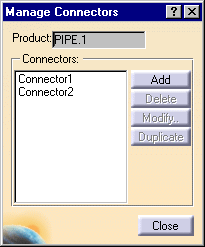
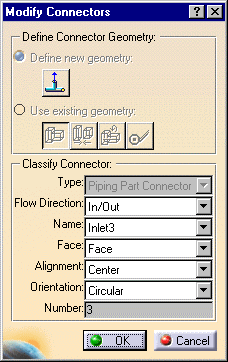
In some applications the type and flow direction fields will be available. The piping (or tubing) part connector has flow direction built in and you must select a flow direction also from the drop down menu. The mechanical part connector has no flow direction.
Another type of connector - the nozzle connector - will be available if you are placing a connector on a nozzle. A nozzle connector must be placed on the end of the nozzle that connects to equipment. A part connector is placed on the end that connects to the pipe or duct.
You can name each connector by selecting a name in the Name field. This is useful for some functions, such as designing using a schematic. You do not have to select a name.
The face is generally defined using a face of the part, such as the end of a pipe. Alignment is usually defined using a line, such as the not-shown line along the centerline of a pipe. Orientation is defined using the xy plane, or another plane or face to define an "up" direction.
In the illustration below the Z axis indicates the alignment of the connector. It also indicates the direction in which routing will occur. The X and Y axis together define the orientation. They are useful when attaching two resources.
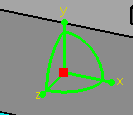
It is necessary to select geometry in the part to which you want to attach a connector so that these three characteristics are correctly defined. If the part does not have the necessary geometry then you must create it.
![]() Click the Select Face
button to select a face. Selectable faces will highlight as you move your
pointer over the part.
Click the Select Face
button to select a face. Selectable faces will highlight as you move your
pointer over the part.

![]() Click this button to select the alignment. You will only be able to
indicate the alignment by selecting a line - from the construction
geometry, or elsewhere in the part if there is one. You can only select a
line that is perpendicular to the face plane.
Click this button to select the alignment. You will only be able to
indicate the alignment by selecting a line - from the construction
geometry, or elsewhere in the part if there is one. You can only select a
line that is perpendicular to the face plane.
![]() Click this button to select the orientation. You will only be able to
select a plane that is perpendicular to the face you selected.
Click this button to select the orientation. You will only be able to
select a plane that is perpendicular to the face you selected.
![]() Some connector types
for hangers (explained below) require you to place a datum point. The datum
point is placed by clicking the button and then clicking a 3-D point on the
hanger.
Some connector types
for hangers (explained below) require you to place a datum point. The datum
point is placed by clicking the button and then clicking a 3-D point on the
hanger.
You can display the part construction geometry, if there is any, to make it easier to select existing geometry. Do this by:
- Right click on the part entry in the specifications tree.
- Click Hide/Show. The part will disappear from the screen.
- Click the Swap Visible Space button
 . The part will
reappear on your screen with the construction geometry visible. Clicking
the button again will toggle you back.
. The part will
reappear on your screen with the construction geometry visible. Clicking
the button again will toggle you back.
For Type, select the type of connector you need.
An attach part connector is used at the attach location of downcomers for attaching the hanger to a bulkhead, etc. All hangers must have this connector to attach to a structure. When you create this type of connector you must also define a datum point. The datum point is defined by selecting a 3-D point that was created when the hanger graphic was built. In the case of an attach part connector it is most often placed at the base of the hanger, and serves as the point from which the downcomer length is measured. The image below shows an attach part connector, and a datum point (the X at the bottom tier).
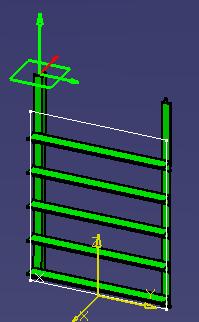
Support part connector: This is used to route cables or pipes through the hanger. It is placed on a tier or the center of a piping clamp. For electrical applications, place one connector on a tier - this will accommodate all the cables there is room for. For non-electrical applications, place as many connectors as there will be runs through the hanger. It does not need a datum point. Also, for electrical applications you must select the appropriate geometry, because it will determine the direction of routing and the plane on which the cables will be placed. The image below shows the green arrow pointing outward - this is the direction of routing. The red arrow (orientation) is pointed upwards, this means the cables will place on top of the tier. If the red arrow points downward the cables will be placed on the underside of the tier.

Hanger part connector: Used for electrical applications only. This is used for routing the lofted pathway. You need to place a datum point on the 3-D point you created in the center of the envelope profile sketch. It is used to create the spline that runs through the loft. The image below shows a hanger part connector and a datum point (the X in the center).
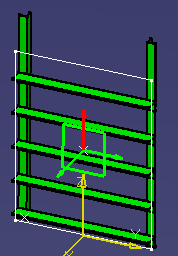
For Flow direction, select None.
Select the Face type. A Hole connection allows a routable to pass through it - it is useful for placing parts like clamps along a run without cutting a tube. A Face connection will stop a routable and not allow it to pass through. For the support and hanger part connectors you need to select Hole. For the attach connector, select Face.
Select an alignment for the support connector. Doesn't apply to the others.
Choose an orientation: Circular will allow the connector to attach to another connector at any orientation; round ducts and pipes, for instance, do not need a well-defined "up" direction because they can rotate. A Rectangular orientation is used for parts like rectangular ducts; they do not have a strict ''up" direction. Up allows the connector to attach to another connector or part in the up position: horizontal trays, for instance, require a well-defined "up" position. You can also use the "up" orientation for a hole connector. In the image below, the connector on the right has the up orientation, the connector on the left does not.

The number in the Number field is assigned by the application. This can be significant because when you are creating a new connector, you have the option of using the alignment and orientation used in the previous connector after you select the face. You can choose to do this, or select a new alignment and/or orientation.
![]()